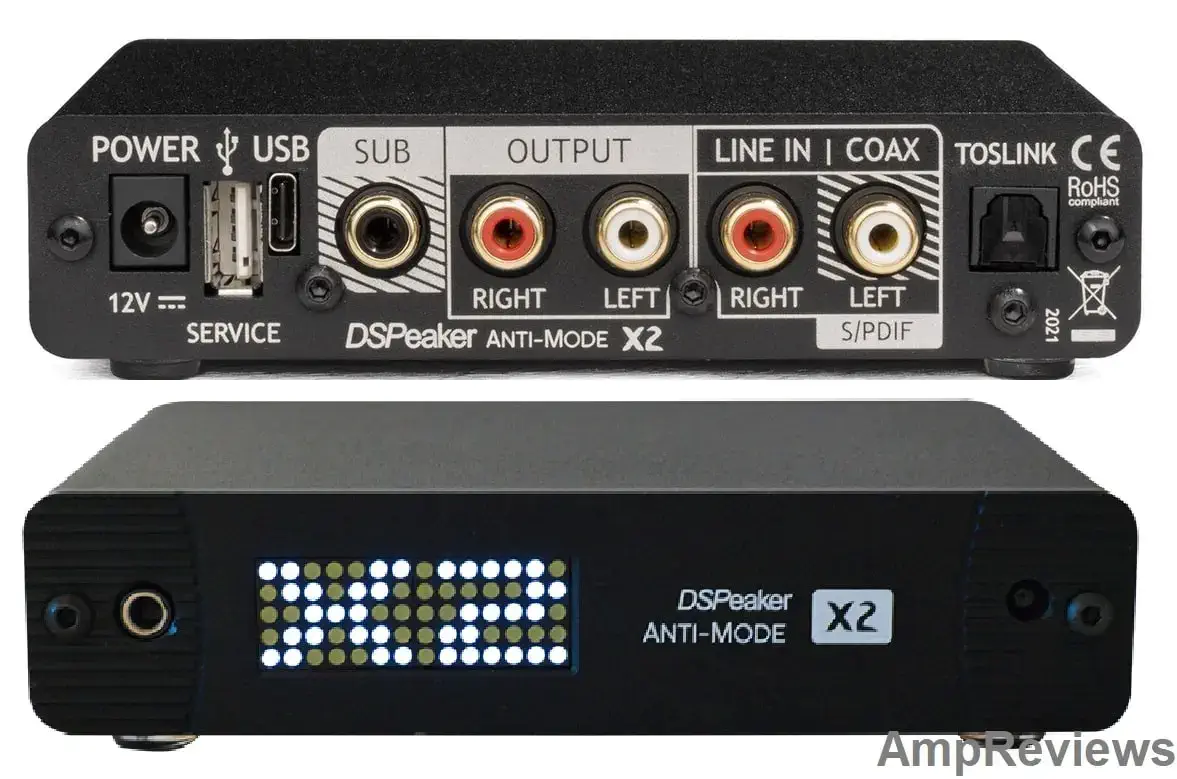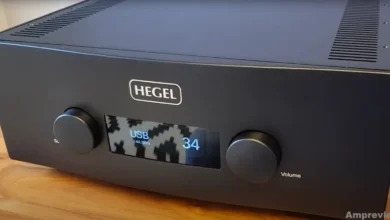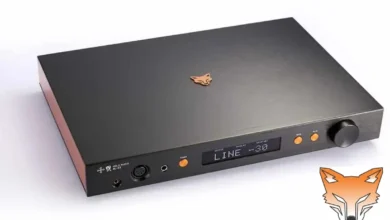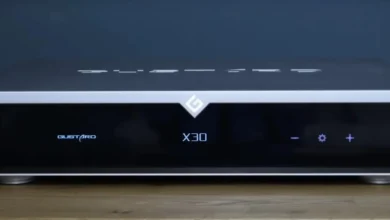

In my opinion, the DSPeaker Anti-Mode X2 is the product everyone needs, but it can hardly be classified due to the lack of competition. The younger fellow of the already tested DSPeaker Anti-Mode Dual Core is a room equalization for loudspeakers and subwoofers. But it can also be used as a preamplifier in minimalist setups – similar to its big preamplifier/processor fellow DSPeaker Anti-Mode X4 – of course then still with equalization and even bass management. But I think many individuals will only use the X2 as a better choice for a subwoofer equalizer in their home theater setup. Because it’s awesome at it.
How to connect the DSPeaker Anti-mode X2?
For the connection setup, a typical application for the DSPeaker Anti-Mode X2 is room equalization. So the reduction of drone frequencies in the room, which are called room modes in technical jargon. For this function, the small device is looped into the signal path before the power amplifiers. This is of course easiest to do between separate preamps and power amps or if you are using active speakers.
But as you already know many of the integrated amplifiers can also be separated, and some models even have dedicated loop-in options for equalizers and and the equalizers like the X2. Almost all classic stereo amplifiers offer at least a tape monitor, which hardly anyone uses today. The DSPeaker processor can also be looped in here. But If you now activate the tape monitor, the current source goes out at the tape, through the X2 and – then equalized – back into the preamplifier. In this way, even older stereo systems can be upgraded with modern room equalization.


And that’s exactly how I made my first sound tests with the X2 using a tape monitor that was looped in. For this, I used the Atoll IN200 Signature integrated amplifier, which I value very much. First comparison: Pure Atoll versus DSPeaker Anti-Mode X2 linear without measurement. You can say: that the X2 was almost transparent, i.e. not audible. It’s also clear: purely analog, then digitized, and then converted back to analog. Everything runs on the same clock: the relative jitter = zero. The sonic impact of such a self-contained digital device is no greater than that of a good analog component.
Calibration DSPeaker Anti-mode X2
For calibration, I fixed the measuring microphone on my selfie light tripod and positioned it exactly at the listening position. The calibration is really simple: plug the microphone into the X2, then the process starts. Then use the cursor keys to select whether 2.0 or 2.1 should be measured. A level tone then starts and the display shows with level bars and “+” or “-” whether you should turn it up or down to calibrate the level. In the meantime, you should have left the sound field if possible, so as not to disturb the sequence of very slow tones. When they fall silent, the display symbolizes that you should unplug the microphone.
Features of DSPeaker Anti-Mode X2
The X2 has two input channels, USB or simply analog. Unusual: The “Left” input socket is either the left analog channel or coax digital input. Up to 24Bit/192kHz can be delivered digitally, internally the signal processing works with 24Bit/96kHz. The three output channels are stereo plus subwoofer with bass management, i.e. actively filtered. To make it clear: in 2.0 stereo mode, two subwoofers can also be equalized. The service socket is used to update the firmware using a USB stick.
Although the display dominating the front only has a resolution of 14 x 5 pixels, it is cleverly used with abbreviations and graphics and is therefore easy to read even from a distance. Another feature on the front is the microphone input.
As you can imagine: everything is handled via the remote control. It offers just six keys plus a cursor. However, this covers everything in everyday life, and for functions that are used less often and deeper configuration, the EQ button serves as a shift for further features. By default, the cursor keys up/down serve as a practical volume control. Practical: With the “Profile” symbol at the bottom right, three different settings can be saved and called up.
You May Also Like: DSPeaker Anti-Mode X4 Review
As has long been customary with DSPeaker, a long cable is included, at the end of which a microphone capsule is soldered and fixed with shrink tubing. That certainly saves costs. A capsule without a housing also has acoustic advantages, but you have to improvise quite a bit to fix it on a tripod…
How does equalization sound?
Unfortunately, DSPeakers do not reveal how their filters work. But it sounds really good. As can be seen in the measurement of the output signal of the calibrated X2, the filters produce practically no phase rotation, which indicates FIR filters. In the fundamental and bass tones, the phase angles seem to cause a group propagation time correction. There is no filtering at all above two kilohertz.
It sounded fantastic. The bass gained contour, the somewhat unbalanced basic tone now seemed well-balanced and streamlined. Voices gained timbre. Impulsive instruments such as snare drums or vibraphone seemed crisper without becoming aggressive. Room sizes and reverberation seemed more realistic. In short: The overall sound was tidier and grooved nicely musically.
In the second attempt, I connected the Trinnov Altitude 32 (in bypass) analogously as a stereo preamp to the DSPeaker Anti-Mode X2 and from there directly connected it to a power amp to the speakers and an active subwoofer: a new calibration as a 2.1 configuration. With the current firmware (as of 09.2022), the crossover frequency cannot yet be selected and is locked in at 80Hz ex-works. This should be adjustable in future versions.


In the test, however, the fixed setting also worked very well in terms of sound – not to say: really great. Few automatic measurements achieve such a seamless coupling of the subwoofer to the loudspeakers. The bass had rich volume and sharp contours. In the fundamental and midrange, the same came out as before without the bass cube.
Once measured, the X2 offers further parameters for taste adjustment of the sound balance. A subsonic filter called INFRA blocks the lowest frequencies to relieve the amplifier and protect the loudspeakers/subwoofers. Then there are the classic tone controls for treble and bass and a midrange control with an adjustable frequency. As already mentioned, three settings can be stored with profiles.
The X2 is not capable of completely manually editing the equalizer or specifying target curves. If you need something like this, you need the DSPeaker Anti-Mode Dual Core . Or you can go straight to the complete preamplifier/processor DSPeaker Anti-Mode X4 . The X2, on the other hand, aims for a solution that is both inexpensive and practical and simple, which even the layman can use without compromise. Whether in a stereo setup or even as a mini desktop preamp for the PC with active monitors. I would say: That’s a straight one.
Conclusion DSPeaker Anti-Mode X2
It’s really smart what the Finns have developed here. The DSPeaker Anti-Mode X2 can be used either as a small preamplifier with D/A converter or as a pure acoustic processor retrofit in (almost) any stereo system. If you can connect it correctly, subwoofers can also be controlled with it. Then the DSPeaker AM X2 enables a homogeneous, perfectly seamless sounding 2.1 playback. And if you want to do it consistently, you can use the DSPeaker Anti-Mode X2 X2 to optimize two subwoofers in your home cinema or stereo system.
The DSPeaker Anti-Mode X2 X2 sounds neutral and transparent in the truest sense of the word and the automatic calibration worked perfectly. The algorithms know how to purify and tidy up the sound almost perfectly. With the DSPeaker Anti-Mode X2 X2 calibrated, it sounded more precise, crisp and spatially plastic in all listening tests and in all rooms in which I carried out tests – without losing character or sounding sterile.
On the contrary. It sounded more musical, richer in timbres. The fully automatic connection of the subwoofer to the speakers in 2.1 mode was amazingly seamless. I liked the minimalist operating concept. Cool: the DSPeaker Anti-Mode X2 only needs 1.5 watts of energy to operate! This is definitely a room equalization solution that anyone suffering from boomy bass should try as a solution. Even digital phobics.
Technical Specifications DSPeaker Anti-Mode X2
Firmware Highlights
- Anti-Mode™ 3 correction
- Cross-over for speakers and sub
- Automatic channel balance
- Tone controls
Interfaces
- Analog Stereo or 1 coaxial S/PDIF digital input (mutually exclusive)
- 1 optical S/PDIF digital input
- S/PDIF: 16 to 24 bits PCM, 32 / 44.1 / 48 / 88.2 / 96 / 176.4 / 192 kHz
- USB Audio input
- Analog Stereo RCA output (Anti-Mode X2)
- Toslink optical and coaxial S/PDIF digital stereo output (Anti-Mode X2D)
- Analog subwoofer RCA output
- Microphone input
- IR remote control (controller included)
- Service USB port for firmware update (USB memory stick required)
- USB Audio 1.0 Stereo 24-bit up to 96kHz PCM (no drivers required)
Analog / Digital specifications (typical)
- Frequency Range (analog to analog): 5Hz to 22kHz
- Analog Input: 2.3 Vrms (max), SNR 100 dB, THD (-6 dB level) < 0.002 %
- Line output (X2): 2.2 Vrms (max), SNR 107 dB, THD (-6 dB level) < 0.0015 %
- Coaxial and Toslink optical S/PDIF output (X2D): 96 kHz, 24 bits
- Subwoofer output: 2.3 Vrms (max), SNR 100 dB, THD (-6 dB level) < 0.03 %
- Power consumption: active 1.5W, stand-by: 0.1W
Mechanical
- Unit Weight: 0.3 kg
- Unit Dimensions: 126mm (width) x 80mm (depth, without cables) x 28mm (height)
- Measurement microphone and remote controller included
FAQs DSPeaker Anti-Mode X2
1. What is the DSPeaker Anti-Mode X2?
- The DSPeaker Anti-Mode X2 is a Compact but extremely powerful room correction unit with
remote-controlled preamp and able to optimize the performance of your audio system, especially For Subwoofers.
2. What Exactly DSPeaker Anti-Mode X2do?
- The DSPeaker Anti-Mode X2 analyzes the room’s Speakers and subwoofer properties and applies digital signal processing to correct any irregularities in the frequency response, particularly in the bass frequencies. It can help stop waves, and handle bass peaks, resulting in a smoother and balanced sound quality.
3. How does DSPeaker Anti-Mode X2 work?
- The DSPeaker Anti-Mode X2 works by measuring the room’s acoustic response using its built-in microphone. It will automatically apply digital filters to the audio signal to compensate for any anomalies detected in the frequency response.
4 What are the key features of the DSPeaker Anti-Mode X2?
- Automatic room calibration, parametric equalization, crossover frequency adjustment, phase correction, and various connectivity options are some of the key features of the Anti-Mode X2. It also offers both automatic and manual modes for fine-tuning the audio performance according to user preferences.
5. How do I set up DSPeaker Anti-Mode X2?
- As I mentioned above setting up the Anti-Mode X2 involves placing the microphone in your listening position, running the automatic calibration process, and connecting the device between your audio source (such as a preamplifier or AV receiver) and your power amplifier or subwoofer.
6. Is DSPeaker Anti-Mode X2 compatible with my system?
- Yes: The DSPeaker Anti-Mode X2 is compatible with a wide range of audio systems, including stereo setups, home theater systems, and professional audio setups. You can use DSPeaker Anti-Mode X2 with any audio setup that has analog or digital outputs.
7. What are the benefits of using the DSPeakers Anti-Mode X2?
- The main benefit of using DSPeaker is to correct room acoustics and optimize the audio performance of your sound system, the DSPeaker Anti-Mode X2 can enhance clarity, detail, and accuracy in the sound reproduction, particularly in the bass frequencies.
8. Can I use the DSPeaker Anti-Mode X2 with two subwoofers?
- Yes, You can connect DSPeaker Anti-Mode X2 with two subwoofers and can optimize their performance collectively to get more bass response.
9. Does it require any maintenance?
- NO. The Anti-Mode X2 is designed to be a plug-and-play solution with minimal maintenance requirements. However, it’s recommended to recalibrate the device from time to time to get optimal performance, especially if there are significant changes to the room’s speakers or the audio system configuration.
10. Where can I the DSPeaker Anti-Mode X2?
- You can buy DSPeaker Anti-Mode X2 or you can find all the authorized retail dealers at DSPeaker’s official website Here.
- Note: It is advisable to buy from reputable sources to ensure authenticity and warranty coverage.





GIPHY App Key not set. Please check settings